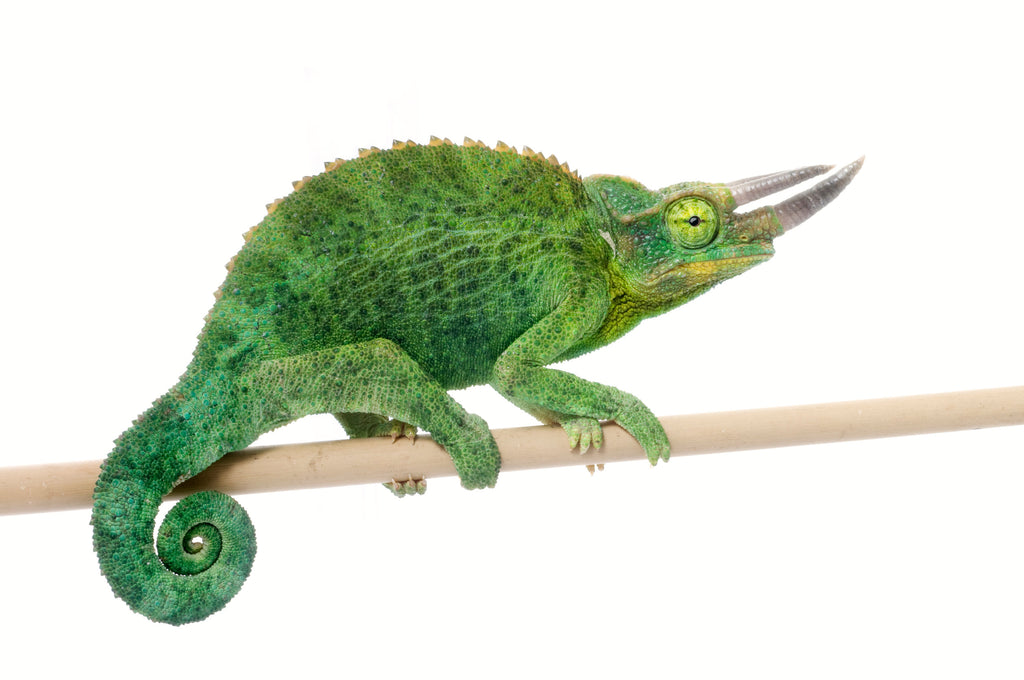Jackson's Chameleon Caresheet and bioactive maintenance

https://www.youtube.com/watch?v=RpWuslEBolM
Jackson's chameleon
A beautiful, one of a kind live bearing chameleon found in the region(s) of Kenya. With 3 total localities available in the hobby these chameleons are very expensive to properly maintain and require lots of space. They are unable to be kept together and have specific husbandry requirements that are for advanced keepers only. These chameleons are sexually dimorphic. Males have prominent horns on their craniums while females lack these horns. These amazing chameleons will vary in size from 8" -12 with males being larger than females.
Trioceros jacksonii xantholophus, or “Xanths” as they are affectionately known, are the largest of the subspecies. They are an overall lemon-lime green with the males having yellow spikes down their backs which earns them their common name of “Yellow-crested Jackson’s Chameleon”. The males have three horns while the females have none. There are occasionally specimens of females with small attempts at horns, but these remain quite rare. (1) -Chameleon Academy
Trioceros jacksonii jacksonii is a catch-all subspecies which covers everything which isn’t a T.j.xantholophus and isn’t a T.j.merumontanus. And that is quite a bit. It covers diverse populations that appear different, are geographically isolated, and live at different elevations. There is no doubt that this subspecies will be broken up further. The most notable member of this subspecies comes from the Machakos Hills region. The Machakos Hills Jackson’s Chameleon is of a smaller build than the Xanths, but the brightest colored males have a vibrant yellow swash across their flank and blue cheeks. The females cause no end to confusion as they, too, can have horns. They will have either three horns like the male or one rostral horn. Their elevation is similar to T.j.xantholophus and their care is identical. (1) Chameleon Academy
Trioceros jacksonii merumontanus, or the Mt. Meru Jackson’s Chameleon, is found on Mt. Meru in Tanzania. It is a much higher elevation chameleon and so is acclimated to deeper nighttime temperature drops and higher UVB levels. It is small and sometimes called the Dwarf Jackson’s Chameleon. This is a colorful species with extra long horns for its little body. The females will have one horn. (1) Chameleon Academy
Requirements
- Enclosure 18x18x36 minimum for adults - A 24" x 24" x 48" is recommended for a lone adult for the best care.
- Chameleon tree pouch
- Terra firma kit or jackson chameleon kit
- Basking lamp
- Plug-in lamp dimmer
- Arcadia 6% UVB T5 Bulb - A 12% can be used with very tall and large enclosures
- Plant light
- Zilla 24/7 Digital Timer Power Center power strip timer
- Temp gun
- Exo Terra 2qt Mister sprayer
- Bio Dude Digital Thermometer / Hygrometer
- Clean up crew pack
- Trees - Ficus, Hibiscus, Schlefflera are great options. Large, vining plants that provide dense cover and shade areas recommended.
- Vines - Stay away from fake moss vines and the like. Natural woods or vines such as Pothos, Philodendrons are recommended.
- Branches - Cork Bark, Manzanita Branches, Ghostwood and other branchy woods are recommended.
- Water bowls/ Food bowls. Chameleon Bug Bar is a great resource.
- Vitamins - No D3 since UVB is provided. Multivitamin once every 2 weeks.
Screen Terrarium - NO GLASS!
A Zoomed or Exo Terra 18x18x36 screen terrarium is the minimum we would recommend, larger is always better for any reptile. They are arboreal and need room to climb; the screen enclosures offer you space for the plants to grow, giving the reptile space to hide and the room to explore while giving airflow, as stagnant air can cause respiratory issues very quickly in chameleons.
Substrate
The Terra Firma substrate mix the dude has created is perfect for these guys. Since screen is best for this species, chameleon pouches help keep the substrate mix and clean up crew inside the screen enclosure. The dudes kit includes extra moss to fill the gaps around the sides of the pouch. This substrate was developed to be used for egg laying chameleons so the tunnels hold and do not collapse on the females, being this is a live bearing species, they will not use it for eggs but it is great for the clean up crews tunnels and plant root growth.
Decor
They will climb on every inch of space available. Making sure sturdy sticks and woods like grape vine, cork bark hunks and driftwood are secured properly, with Plants and trees like Schefflera, bromeliads, ficus, pothos and palm options acting as decor and enrichment. The Dudes kits come with plants and decor, you can reach out to the store through our customer care email to obtain information about which are available at the time the kit is purchased. The plants require a separate LED bulb; we recommend the Dudes Glow and Grow.
UVB and Basking spot
Like all chameleons they need a good UVB source, however unlike most species these chameleons like it cooler. The decor will need to be placed with the UVB and basking element in mind so that the chameleon will have adequate basking spots and hiding spots to get away from the light at the same time.
Heating
- Basking 85-90 F
- Ambient 75-83 F
- Night time 63-70 F
- UVB bulb -6% Arcadia or Zoo Med T5
Depending on the temperatures of your home coupled with the UVB and LED bulbs, the temperatures may be high enough to not need a higher wattage heating element. You can use a variety of elements to achieve the temperatures you need so long as they are connected to a thermostat.
Humidity
Chameleons dehydrate very quickly. To ensure that humidity spikes are maintained throughout the day, we recommend Utilizing a Mist King or a homemade misting system is the best way to go for species that need higher levels of humidity, and jacksons need 50-80% regularly. Using plants that can hold water on their leaves so the chameleon can lick it off is a great way to enrich them in a naturalistic way, while keeping them hydrated. Random dry periods help keep the levels from getting too high, a hygrometer will help keep track of the levels, placing the probe in a shaded area for proper readings.
Food
Being insectivores, jackson's eat a variety of roaches, worms and flies, which can be offered using a feeding cup attached to the side of the enclosure, in a heavy bottomed bowl on the floor of the enclosure, or by tong feeding. Tong feeding is a great way to associate the human animal bond with your pet. Feeding should be done every other day to every two days. It is essential to provide a varied diet with all insects being properly gut loaded for maximum health. Insects should be dusted with the appropriate calcium and multivitamin supplement. Calcium without D3 should be utilized with a multivitamin
Handling
Chameleons in general are more of a reptile look at pet, but most of them will tolerate gentle handling. The best way to get a chameleon out of the enclosure is to do the hand to hand method, letting them walk onto your hands on their own or with gentle coaxing, they will happily use you as a tree. Take care to offer full body support while handling so the animal feels as secure as possible.
The Dude Abides
(1) - Reference: https://chameleonacademy.com/jacksons-chameleon-care/
- Josh Halter








